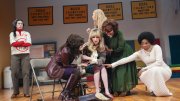In the annals of undergraduate housing, the graduation of the class of 2001 marked the end of an era. My freshman year, the seniors weren't "randomized"--they were the last class allowed to matriculate to their Houses according to some vestige of a choice system. Granted, we never lived in the Houses with them--but we heard tales of the grand old days when Adams was a haven for gays, when Kirkland (and later Mather) teemed with jocks, when Quincy was heavily Asian and the Quad was heavily black.
Randomization means little to today's freshmen; in a population that replaces itself every four years, institutional memory is short. But whether or not today's students realize it, the shift to randomization--taken in a series of gradual steps, each one moving further from the masters'-choice system of the Houses' early days--has undeniably changed the undergraduate experience at Harvard. Now that the dust has settled, the concentrations of certain groups in certain Houses are gone and increasingly forgotten. Though many decry the loss of that kind of House identity, a new social dynamic has filled the vacuum after a few rough years. In fact, interhouse transfer applications have been steadily on the decline since the 1995-96 school year; senior survey numbers show significantly less dissatisfaction with the House system and the housing assignment process than before randomization (see chart on page 79).
Gone with the institutional memory are many champions of the old system. One of those champions is Loker professor of English and former Adams House master Robert Kiely, who voiced steadfast opposition to the new measure in the days when it was under consideration. The House he oversaw--and the one where I lived--had a particularly strong identity and faced major change with randomization. "Gay and lesbian students were scattered throughout the College, but Adams House became the place where they had their dances and the place where they had their weekly meetings. The first leaders lived there. I was one of the first faculty advisers," says Kiely. "Students said to me over the years how important it was to have the feeling of support from the rest of the House." Though he estimates that, even at its peak, the gay and lesbian population made up only 10 to 15 percent of the House, Kiely says Adams's tolerance was its true trademark. "A lot of students who, for a whole variety of reasons, didn't feel they belonged in whatever they perceived the rest of Harvard to be, found a haven in Adams House," he says. "I felt very protective of that."
Those who weren't fans of randomization question its validity all the more because, they say, the legend that has developed far exceeds the reality. "Students now tend to romanticize the stereotypes, but I don't think the self-segregation was as stark as people are portraying it," says Shirley Thompson '92, Ph.D. '01, who lived in Adams as an undergraduate and then observed it post-randomization in the four years she served as a resident tutor. Though she is black, Thompson says she didn't even think of listing the Quad as one of her choices: "I didn't want to have to walk that far." Instead, she ended up in Adams House. "Just out of curiosity, I was glancing through an old House facebook, and there were actually quite a lot of black students in Adams--a lot more than there are now," she says. What's more, she adds, her blocking group was "very diverse nationally, racially, ethnically, gender-wise, sexual orientation, interests, you name it. There were a lot of other groups similar to mine. We had athletes as well as artists. Some people were both. The administration talks about these groups as if people are one thing or another and that's it."
But whether or not the Houses were diverse, stereotypes did exist--and were no doubt harmful. College administrators argued their case with the dissenters, but eventually pushed randomization through, to take effect in the spring of 1996.
That decision stands in the minds of my classmates as a turning point in the history of the College. But dean of the College Harry R. Lewis maintains that it was more a turn back toward the past: a fine-tuning of the housing policy to better reflect the original intent of the founders of Harvard's residential college system. He points to the Reports of the president and treasurer of Harvard College for 1927-28, in which then-president A. Lawrence Lowell wrote that the Houses were places where "men interested in various fields of thought should be thrown together with a view of promoting a broad and humane culture." Lowell made no bones about his attitude toward students' tendency to associate with those of their own kind, writing, "So far as subjects of concentration, pecuniary means, and residence in different parts of the country are concerned, each House should be as nearly as possible a cross-section of the College."
In the "real world," said randomization's opponents, individuals choose their associations and are free to segregate themselves in homogeneous communities if they wish to. "Randomization is unnatural!" they cried. Lewis has never denied that. His point is that this unnatural environment might effect some change, so that graduates aren't as likely to segregate themselves after they get out. "It is not the objective of the residential system to make every student as comfortable as possible," says Lewis. "A certain level of discomfort is part of our educational obligation.
"This is definitely an issue of individual freedom versus community good," he continues. "It's always been my belief that on matters of general community importance like this, you don't make the decision based on a preponderance of student opinion." In a self-segregated system, a student could conceivably spend four years without interacting in any significant way, outside the classroom, with someone from a different cultural background. And the very idea of a residential college is that learning continues outside the classroom. "The academic and non-academic halves of the undergraduate experience had grown increasingly distant from one another," says Lewis.
But immediately following the implementation of randomization, a funny thing happened: students began using a different tool to self-segregate. The average blocking-group size crept swiftly upward toward the maximum of 16. And for the first time, the blocking group became a central feature of Harvard undergraduate life. "When I was an undergraduate, 'blocking group' was a term people used freshman year only, when they were getting into their Houses. Now we have sophomores, juniors, seniors who still talk about their blocking groups," says Jamie Ciocco '94, who lived in North (now Pforzheimer) House as an undergraduate and has served as a resident tutor in Adams for five years. Cut off from living with larger networks of their peers, students chose to stick with 15 people like themselves, instead of fulfilling the administration's hope and branching out. What's more, huge blocking groups--particularly if they were homogeneous--made a truly random population unlikely in any given House. One year Cabot House received very few female sophomores; in another, Mather House had so many varsity athletes that it was in danger of violating the NCAA rule against athletic dormitories. (Part of this was due to the population that existed before randomization, but the new additions pushed it over the edge.) Subsequent administrative fine-tuning ameliorated the situation.
The situation was compounded by students who wanted to preserve the old House personalities at all costs. Even if the residents of a given House were not homogeneous, the culture of each House usually reflected its stereotypes, discouraging some newcomers. "Randomization was particularly tough on Adams House, because at the time I was a freshman, there was a definite population of students who were a little afraid of Adams, who didn't identify with the stereotype of Adams and didn't want to live here," says Ciocco. He recalls an Adams House with people who dressed all in black and smoked in the dining hall, with an unusual predominance of English concentrators and a strong tradition of drama, and with traditions like Drag Night and a sadomasochism-themed Halloween masquerade.
But over time, the edges softened. "When I was a sophomore and attended House Committee meetings, they were non-inclusive and pretty much run by men," says Katie Murphy '01, who served as cochair of the Adams House Committee in 2000. During her first year in the House, the meetings were held in seniors' dorm rooms. "Nobody in my class actually attended," says Murphy. "I was pretty much the only one who broke through the front." But spring semester brought a new--and more inclusive--set of committee chairs: "They had meetings in places that were lighted and accessible." Murphy and her cochair changed things even more a year later: they advertised meetings, putting up posters and sending out announcements over the House e-mail list. House-wide parties filled the Molotov Café, drawing in students who'd previously feared that shadowy, candle-lit basement lair. The new master and co-master, Judith Palfrey and Sean Palfrey, coordinated a series of "Life Seminars," inviting experts to give presentations and lead discussions on such useful topics as cooking the basics, fixing a bicycle, and preparing one's taxes. Immediately post-randomization, attendance at traditional House events--not just Drag Night or the masquerade, but also the Winter Swing and the Spring Waltz--dropped severely. Since then, House chairs have been working to bring the crowds back. "We had a tough time trying to dispel this image of the House as gay, black-wearing, and artsy," says Murphy.
But the loss of that image, and the move toward mainstream, inclusive events, means that something real is also lost. Drag Night and the masquerade, for instance, live on, but the culture that went with them is relegated to further reaches of the College. "Drag night started as a celebration of being out," says Ciocco, who dressed up in a peach-colored, floor-length bridesmaid's gown and matching dyed satin pumps to sing a song entitled "Bridesmaid Blues" for last year's Drag Night. "It was much more of an activist event. Now, for better or for worse, it's become kind of campy, and it's become a lot safer for straight students."
So where exactly has the gay community gone? And for that matter, the black community, the Asian community, the white-collar aristocratic community? The groups needed other means for associating with one another and distributing needed information--and the Internet appeared on the scene at just the right time. Now all that the head of such a group must do is send out an announcement on its e-mail list; most members will likely know about the event within minutes.
Still, extracurricular groups can't always fill the void left when a space-based community is removed. "When you join [the Bisexual, Gay, Lesbian, Transgendered, and Supporters Association], you're necessarily making a statement. It doesn't have to be, 'I'm gay' or 'I am a lesbian,' but it can be a big hurdle to get over," says Ciocco. "These students would be helped by living alongside people who have come out and who have gone through that." What's more, taking away those communities may actually reduce students' likelihood of venturing outside their comfort zones. "If people feel comfortable with the people around them, which happens in living situations with extended networks of friends, then they feel safe to try new things," says Shirley Thompson. "When their community is narrowed down to one group of maybe four or five people and what seems like a kind of anonymous community, then they start to become unnecessarily afraid of other people."
Ciocco, like Thompson, says administrators exaggerate the extent to which students stuck to their own before randomization. "The term 'self-segregation' is part of the language that made randomization inevitable," he says. "I think that having space for a critical mass of students who share your interests is different from self-segregation." He contrasts what happened in his undergraduate House after white officers were acquitted in the Rodney King beating case with the situation he witnessed when the Amadou Diallo shooting in New York City filled the news. "Because [the King case verdict] had deeply affected a large proportion of the House, it ended up involving the whole House community," Ciocco says: the North House common room became a forum for live student debate not only about race relations in Los Angeles but also at Harvard. Eight years later, "the dynamic of the House had shifted to the point where [the New York events] couldn't spark the kind of House-wide dialogue I had witnessed as a sophomore."
The main change since randomization has been another attempt at fine-tuning. Discouraged by students' tendency to form large blocking groups and frustrated by the way these mammoth groups tipped the demographic balances within Houses, the College in September 1999 slashed the allowable blocking-group size in half, to eight. The theory was that without large networks of close friends within their House, students would be more likely to branch out and meet others. This change, coupled with efforts to provide activities that mirror the diverse demographics of each House, has helped facilitate mixing between blocking groups.
At Adams House, for example, tutors and students organized a Chinese New Year celebration in the dining hall; masters' teas included a Southeast Asian and a Central American tea, with food and drink to reflect each cultural tradition. "We invite students to come and meet a group that's doing something different," says Judith Palfrey. "Tomorrow night, they might sit at a different table in the dining hall."
At the same time, the Palfreys have tried to guard against losing the old Adams spirit altogether: last spring, they appeared as a cross-dressing couple in a theatrical production of a French farce staged in Adams's Pool Theater. "We still do struggle to maintain a little of the old character," says Judith Palfrey. "Even if it's just at intramural sports, what's the way that Adams House plays? We come in black T-shirts, we're a little ragtag, we don't always do things by the rules. For masters' teas, we don't get a fancy caterer; we just bake cookies. Even though it's not all the black turtlenecks, I would hope we're still seen as a little bit, in an odd way, counterculture."
The one exception to the supposed loss of community, according to modern folklore of the College, has been the Quad, because of its isolation. Geography encourages Quad solidarity, and Quad denizens commonly boast that life there most closely resembles "life at a real college," something Harvard obviously is not. "There's something very special about being up at the Quad," says James Ware, who began his term as master of Cabot House in the fall of 1996. "It's more distinctive. There's more identity at the Quad; you feel more bonding. In the end, it turns out OK, but there's still a lot of [initial] apprehension and anxiety."
Before randomization, those placed in the Quad were often even less apt to accept their fate positively. J. Woodland "Woody" and Hanna Hastings served as master and co-master of North House from 1975 to 1996. In that capacity, they were charged with the job of generating enthusiasm about a House that routinely placed last, in terms of the number of students listing it as a choice, in rankings published annually by the Crimson. "People threatened suicide if they were assigned to the Quad," says Woody Hastings.
Athletes in particular objected to facing a 30-minute walk before a 6 a.m. practice across the river. The introduction of general shuttle-bus service and the athletic department's new policy of offering athletes cab vouchers have largely alleviated the issue. Renovations to North and Cabot Houses in the late 1980s have also helped, and perks such as the beautiful Radcliffe Quad, a quieter and less hectic setting for study, and a warm, welcoming community (strengthened, in fact, by its distance from the rest of the campus) won most students over. "After a few months, they became fiercely loyal and wouldn't live anywhere else and loved it," says Hanna Hastings.
But that took longer for some students than for others. Precluding that waiting period was a major goal of randomization, says Harry Lewis. "Psychologically, there's an enormous difference between asking people where they want to go and then telling them they can't go there, and just having everyone know it's going to be the luck of the draw."
Whether things are better or worse than they were seven years ago, it's clear that they are different. Though the policy of choice has been lost entirely, its defenders' legacy lives on through conscientious House masters' and tutors' efforts to forge new communities that remain distinctive while embracing diversity.





